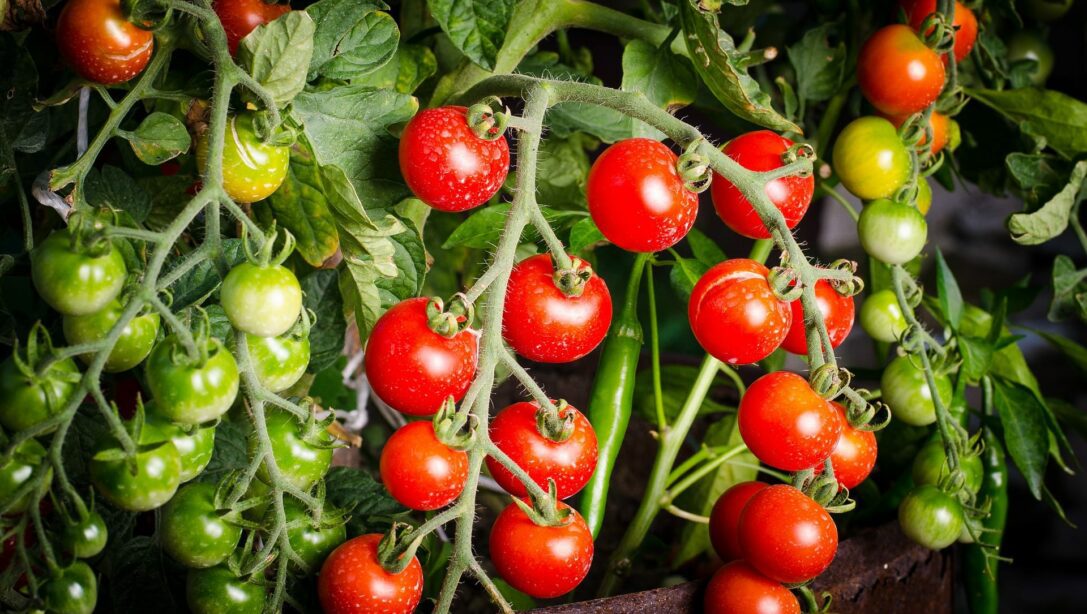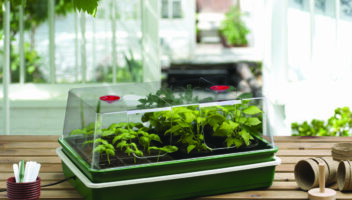Anyone who has enjoyed eating tomatoes straight off the vine will appreciate the sweetly delicious flavour and that distinctive tomato smell. Growing tomatoes is relatively easy, doesn’t necessarily require a greenhouse and is immensely satisfying.
We look at the different ways to start your tomato plants, what you will need as they grow and some of our best-loved varieties.
View our collection of vegetable and herb seedsGrowing tomatoes from seed vs in pots
The most cost-effective way to grow your own tomatoes is to grow them from seed. When growing in a greenhouse, it is possible to sow some varieties of tomato seed as early as January or February. If you will eventually be planting them outside, it will be best to wait until March or April to start sowing indoors, so the weather will have warmed by the time you plant them outside.
Don’t want to grow tomatoes from seed and fancy planting them directly outside? Or want an even greater guarantee of success? You can also purchase small tomato plants that have been taken through the early stages of development. These include grafted plants, where a rootstock from a different plant has been used to produce disease-resistant, higher-yielding crops.
Tomato Varieties
One thing to be aware of when you grow your tomatoes is that different tomato varieties fall into different categories. They could be:
Indeterminate (aka cordon / vine)
With these varieties, the plant continues growing as long as possible, producing fruit until the first frosts. The vast majority of tomato varieties are indeterminate (you may also see them referred to as ‘cordon’).
Determinate (aka bush)
Determinate tomato varieties are typically much more compact than indeterminate vine varieties. The plant puts its energy into one big harvest, leading to an eventual shrub or bush-shaped plant.
Different care is required depending on the type. Essentially, indeterminate varieties require staking to support them as they grow on ever-longer stems and require removal of the side shoots that develop so that all the plant’s energy is put into the fruit produced from the main stem. Determinate and bush varieties are more compact and may well be grown against a cage-style support. Within both types, you will find varieties suitable for growing outdoors and those that need the protection of a greenhouse.
Some of our recommended varieties include:
Tomato ‘Alicante’
A high-quality indeterminate or cordon variety that has the RHS Award of Garden Merit. It is an early producer, with a heavy crop of mid-size red tomatoes with a delightful, sweet flavour.
Tomato ‘Ailsa Craig’
This indeterminate or cordon variety is also an early producer, renowned for its delicious red fruits. This is a reliable variety, especially popular with those who are new to growing tomatoes.
Tomato ‘Sungold F1’
Tomato ‘Sungold F1’ is an indeterminate or cordon-style cherry tomato variety that produces a large number of small, yellow-orange fruits from early summer on. With a delightful sweet flavour, this is one of the most popular varieties of yellow tomato, and for good reason.
Tomato ‘Roma’
The classic “plum” tomato – a bush variety that works best under glass because the extra heat helps this Mediterranean plant ripen.
Tomato ‘Tumbling Tom’
A bush variety with a tumbling or scrambling habit ideally suited to growing in a hanging basket. Classic ‘cherry’ tomatoes.
Grafted Tomato ‘Shirley’
A mid-sized, classically red tomato variety that yields multiple clusters of sweet, juicy and firm fruits.
Grafted Tomato ‘Gusta Mini Red’
A deliciously sweet, vigorously growing cherry tomato variety that produces its fruit early in the season.
Growing Tomatoes From Seed
- Time it Right
Tomato seeds need a temperature of at least 10°C to germinate, and ideally between 15-20°C. If you are growing tomatoes in a greenhouse, you may be able to begin sowing seeds as early as January or February. If you will eventually be planting them outside, wait to sow indoors until March or April.
- Sow Seeds
Sow your tomato seeds into small pots (around 7cm) or in a cell tray. For variety guidelines, always refer to the specific instructions on the packet. Typically, you will fill your pot almost to the top with seed-sowing compost. Place a tomato seed on top, lightly cover with more compost, and very gently water – you may want a small watering can with a fine rose attachment for this.
- Germination
Position the pots in a warm spot inside. Seedlings should appear within 1-2 weeks. If positioned on a windowsill, be conscious that a severe drop in nighttime temperature could hinder germination and even kill the plant. Also, seedlings growing on a windowsill will naturally bend towards the light.
- Potting On
About four weeks after sowing your seeds, they will be ready to be potted on into slightly larger (10cm+) pots if you sowed them in cell trays. At this stage, your seedlings will be around 10cm tall, and the roots will have stretched to the bottom of their first pot.
Carefully remove your plants from their current pots and position them in the middle of the larger pots. Fill in around them with potting compost or a good multi-purpose compost.
Tomatoes are hungry plants, and along with frequent watering, your growing plant will start wanting a regular feed of tomato food a few weeks after potting on. - Planting Outside
If you are planting your tomato outside, once all risk of frost has passed (in late April or early May) you can gradually ‘harden off’ your tomato seedlings before planting them in their final position.
Hardening off simply means acclimatising your plant to life outdoors by placing it outside in a sheltered spot for a few hours a day for a week or so. Increase time outside gradually each day.
There are many options for where to grow your tomato plants outside:
In a tomato grow bag or planter. These have the advantage of coming pre-filled with specially formulated compost. Place one tomato plant per growing square. Pierce the sides of the grow bag if needed to ensure proper drainage.
In containers. Fill a clean, empty container with fresh multi-purpose compost. Remember, tomatoes are hungry plants, so one plant per 30cm container is about enough.
In hanging baskets. Tomato varieties, particularly more compact ones or trailing varieties like Tomato ‘Tumbling Tom’, will grow in hanging baskets if you are short on ground space. Be aware that these will need even greater vigilance with watering and feeding!
Directly into the ground. Prepare the ground well in advance, digging in plenty of quality multi-purpose compost.
Discover a wide range of seeds to help you kickstart your GYO journey.
How long does it take to grow tomatoes?
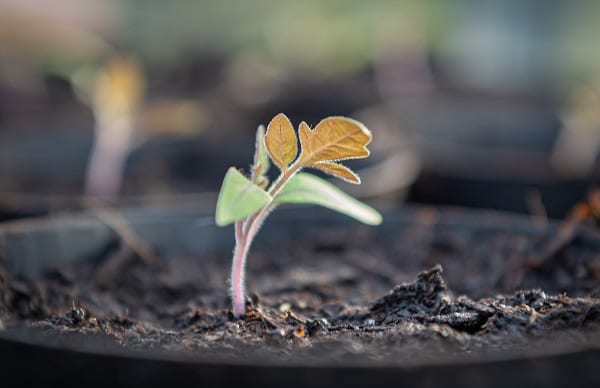
From planting your seeds or plants to producing fresh, ripe and ready-to-eat tomatoes, it takes around 80 days. This is always dependent, however, on the environmental factors that may impact your tomatoes.
How tall do tomato plants grow?
Tomato plants are likely to grow more quickly and produce a bigger crop if positioned in a spot with full sunshine. They will still grow in partial shade, but less bountifully. They also require protection from winds, especially intederminate and cordon varieties, which can reach significant heights. Some can grow up to 6ft tall. You will also need to create support for your plant at the same time as you plant it outside; see below for details.
How to care for tomato plants
Tomato plants are not considered particularly difficult to grow, but you also cannot simply leave them and hope for the best. They do require some TLC as they grow.
Staking Your Plants
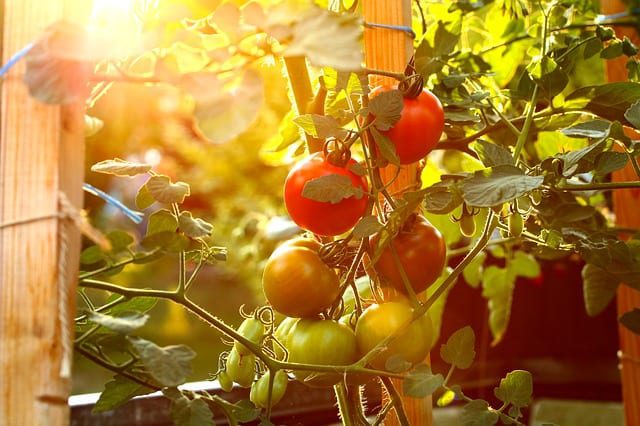
Tomatoes, particularly indeterminate varieties, grow taller and thicker stemmed as they mature, eventually bearing heavy fruit on their stems. This puts them at high risk of the stems bending and breaking if not adequately supported from the start.
Staking
There are several options when staking plants, including simple bamboo canes, spiral posts, A-frames running along the soil and cages, to name a few. Whichever option you choose, it is important that it remains sturdy enough and is tall enough to support your plants through maturity.
As your tomato plant grows, gently tie the main stem to your stake using natural twine or a soft wire for climbing plants.
Pruning Side Shoots
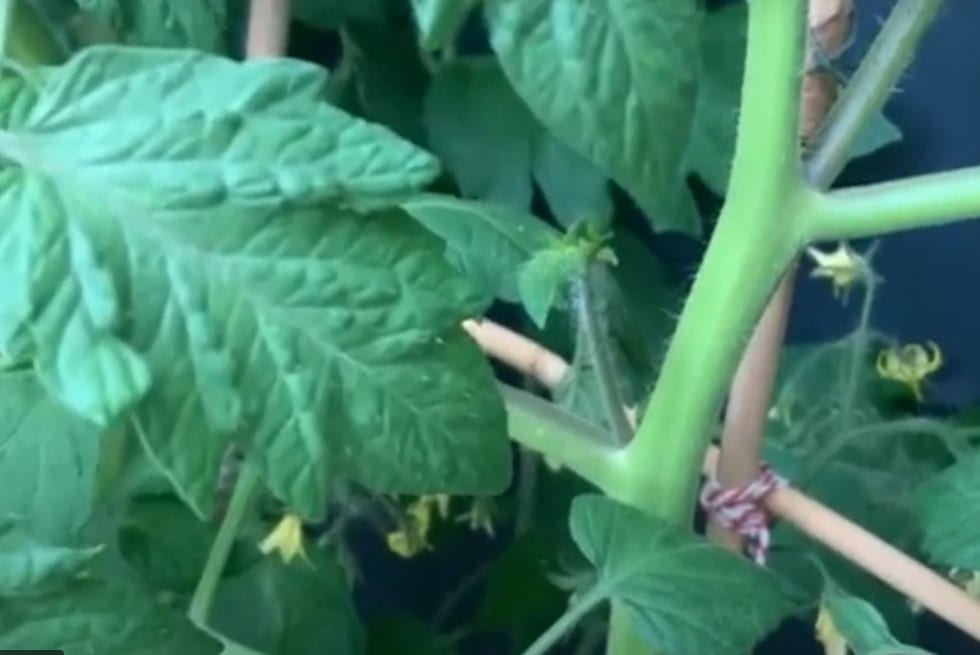
Indeterminate tomato varieties produce side shoots or suckers as they grow. These appear at the junction between the stem and branch. If you simply leave all these side shoots unchecked, your tomato plant will soon develop several large side stems alongside the main central stem, all of which will compete for nutrition.
Pinch these off when you see them to get the best yield from your plant. It is as simple as gently twisting them off with your fingers. Be aware these side shoots can grow extremely quickly; it’s not uncommon to discover you have missed what is now a considerable width side shoot! In this case, just snap it off and place it on the compost pile; your plant will not be damaged. Most growers will “stop” cordon tomatoes by pinching off the main growing tip after 6 or 7 fruit trusses have formed to ensure the best fruit (and because by that time the plant will be a manageable 6-7 feet high), but with sufficient watering and feeding, a tomato plant can be grown as high as you like; commercial growers just keep on growing them to 30 feet or more in tall glasshouses.
Pruning older foliage
As you grow tomatoes, it can also be beneficial to remove some of the older foliage, particularly lower down the plant, so that the fruits can benefit from the warmth of direct sunlight, which will help them ripen further.
Feeding and Watering
Tomato plants have a near-insatiable hunger and thirst. Water thoroughly daily – possibly twice daily during incredibly dry spells. Feed weekly with a dedicated tomato feed.
Hillier Tip
Watering tomatoes on a regular basis is critical. Irregular watering or drought is linked to blossom end rot, which causes dark patches on the ends of fruit and splitting where the skin of the fruit tightens in a period of relative drought and then splits after more water is applied, causing the fruits to swell. It is important to maintain steady growth until the fruits are ready to harvest.
If you are growing tomatoes in the open ground, be conscious that they may take nutrients from the soil at the expense of nearby plants, so make sure they have plenty of space.
Help your tomatoes grow with Big Tom Super Tomato Food and organic tomato feed.
When to harvest tomatoes
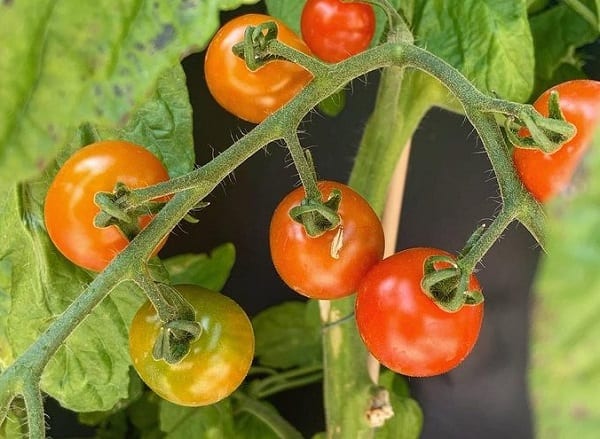
One of the simplest parts of growing tomatoes is determining when they are ripe. Small sets of flowers appear first. Gradually developing into panicles of tomatoes, they progress to their final colour and size – in many cases, a glorious bright red, but this could also be golden-yellow or almost black depending on the variety.
All that remains is to savour the incredible taste and smell of your homegrown tomatoes. Delicious eaten straight from the vine or as an ingredient in a variety of recipes.
Tomato Growing Tool Kit
- Tomato seeds / small tomato plants
- Cell tray or Small 7cm pots and seed sowing compost (if growing from seed)
- Watering can (with fine rose attachment if growing from seed)
- Tomato grow bag / planter (e.g. Levington Tomorite Organic Peat Free 42L Growbag / container + multipurpose compost)
- Bamboo canes / metal stakes / plant cage for support
- Natural twine / climbing wire for tying in
- Tomato feed (e.g. Tomorite)


